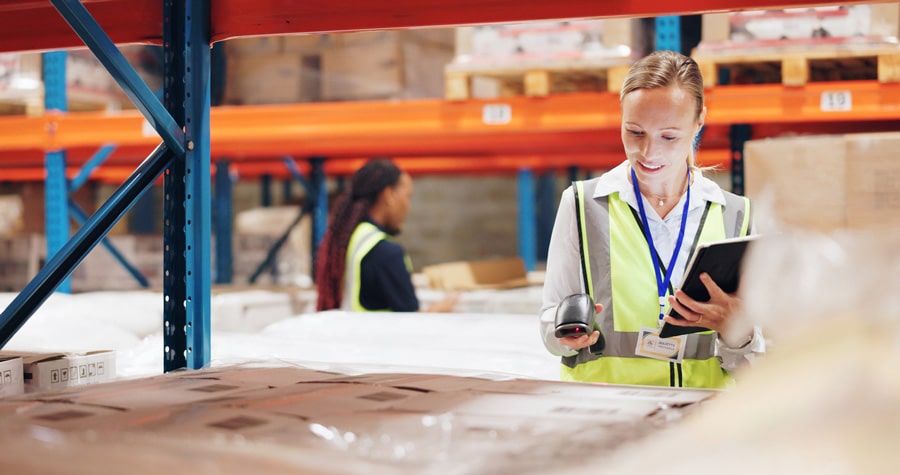2025 in the Warehouse: Automation, AI, and Labor Uncertainty
The warehouse operations market is evolving quickly driven by advancements in automation and robotics, artificial intelligence (AI), sustainability initiatives, and shortages of qualified manufacturing labor. As businesses strive to remain competitive in an increasingly fast-paced market, staying ahead of trends in warehouse operations is more important than ever.
Automation & Robotics: Smarter, Faster Warehousing
Among the biggest trends is the adoption of automation and robotics. Warehouse automation involves deploying advanced technologies like robotics, conveyor belts, automated guided vehicles (AGVs), artificial intelligence, and machine learning to streamline warehousing processes. These technologies aim to enhance efficiency, accuracy, and productivity in tasks such as inventory management, order fulfillment, and logistics operations.
Warehouse automation is no longer a luxury — it’s a necessity. From robotics and conveyor systems to AI-driven sorting and automated guided vehicles, technology is redefining efficiency.
- Improved accuracy & productivity – Automated systems streamline inventory management, picking, and packing.
- Cost savings – While the upfront investment is significant, long-term savings on labor and errors make automation worthwhile./li>
- Scalability – As technology advances and costs drop, automation is becoming more accessible for businesses of all sizes.
While the initial investment in robotics can be high, long-term savings in labor costs and increased efficiency often outweigh the costs. Big-box retailers have been at the forefront of this trend, utilizing robotic systems to revolutionize their warehouse operations. However, as technology becomes more affordable, smaller businesses are also beginning to adopt these solutions.
For example, smaller companies are beginning to implement Internet of Things (IoT) technology, using RFID tags, sensors, and real-time tracking to reduce shrinkage, optimize storage, and improve visibility.
Meanwhile, wearable technology and augmented reality (AR) are making warehouse teams more efficient — providing hands-free data, improving safety, and reducing training time.
See how Capstone helped a food distribution partner increase productivity by 25% and save $250K annually compared to in-house operations.
AI & Machine Learning: Turning Data into Action
Warehouses generate an incredible amount of data — and AI is the key to making it actionable. Machine learning algorithms analyze historical trends, optimize workflows, and predict demand before stockouts happen.
- Smarter inventory management – AI forecasts customer demand, ensuring optimal stock levels.
- Optimized storage & picking – Machine learning determines the most efficient product placements and retrieval paths./li>
- Predictive maintenance – AI monitors equipment performance, preventing downtime before it happens.
To take advantage of the growing amount of data, AI and machine learning (ML) are being embraced in warehouses. AI-powered solutions help warehouses become more agile and responsive to changing market conditions, ultimately improving customer satisfaction.
For example, AI and ML can be used to optimize inventory management by forecasting customer demand, ensuring optimal stock levels, and analyzing historical data to determine the best storage locations for products. Additionally, AI monitors equipment performance to predict and prevent breakdowns, reducing downtime.
As supply chains become more complex, AI-powered solutions help businesses operate with greater agility, visibility, and responsiveness.
Addressing Warehouse Labor Shortages and Uncertainty
With an aging workforce and shifting industry perceptions, the manufacturing and logistics sectors are facing a growing labor shortage. Deloitte projects 3.8 million new manufacturing jobs will be needed by 2033, with nearly half potentially going unfilled if current trends continue.
The issue is compounded by a number of factors, including an aging workforce, rapid technological advancements, and shifting perceptions about careers in manufacturing. On top of this, uncertainty abounds in the labor market with rapid changes in federal funding, immigration laws, tariffs, and other government changes that could impact businesses.
To combat this, businesses are:
- Investing in workforce development — Training programs ensure employees keep up with new technologies.
- Outsourcing to fill labor gaps — Turning to smart, technology-forward firms to find skilled, productive labor when recruiting is difficult or production gaps occur.
- Offering competitive wages & benefits — Attracting and retaining skilled workers is essential to keeping operations stable.
- Leveraging automation — Strategic use of robotics and AI helps reduce reliance on manual labor for simple tasks without sacrificing productivity.
The Bottom Line
Warehouse operations are changing fast, and businesses that fail to adapt will fall behind. Whether through automation, AI, or workforce innovation, staying ahead of the curve is key to cutting costs, improving efficiency, and exceeding customer expectations.
At Capstone Logistics, we help businesses navigate these challenges with scalable, technology-driven supply chain solutions.
👉 Contact Us: capstonelogistics.com
#SupplyChain #WarehouseTrends #LogisticsInnovation #Automation #CapstoneLogistics #AI #Sustainability #LastMile

